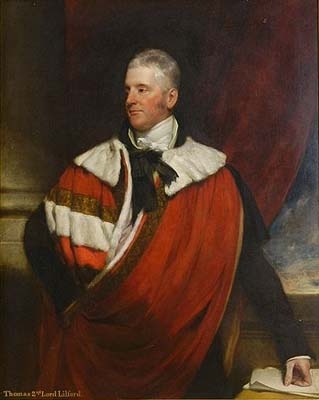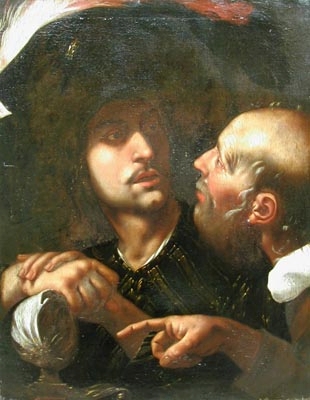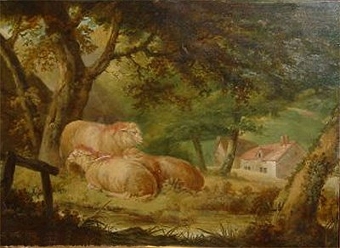portrait of queen elizabeth the second (1926- )
- View other items in:
- antiques interior design modern and vintage
- other interior design
artware ltd
Enquire about this antique
Artware Ltd has 565 antiques for sale.
click here to see them all
The Queen was born in London on 21 April 1926, the first child of The Duke and Duchess of York, subsequently King George VI and Queen Elizabeth. Five weeks later she was christened Elizabeth Alexandra Mary in the chapel at Buckingham Palace. The Princess''s early years were spent at 145 Piccadilly, the London house taken by her parents shortly after her birth; at White Lodge in Richmond Park; and at the country homes of her grandparents, King George V and Queen Mary, and the Earl and Countess of Strathmore. When she was six years old, her parents took over Royal Lodge in Windsor Great Park as their own country home. Princess Elizabeth was educated at home with Princess Margaret, her younger sister. After her father succeeded to the throne in 1936 and she became heir presumptive, she started to study constitutional history and law. She also studied art and music; learned to ride (she has been a keen horsewoman since early childhood); and enjoyed amateur theatricals and swimming - she won the Children''s Challenge Shield at London''s Bath Club when she was thirteen. She enrolled as a Girl Guide when she was eleven, and later became a Sea Ranger. As the Princess grew older she began to take part in public life. She broadcast for the first time in October 1940, when she was 14; she sent a message during the BBC''s children''s programme to all the children of Britain and the Commonwealth, particularly to those children who were being evacuated for safety reasons. In early1942 she was appointed Colonel-in-Chief of the Grenadier Guards, and on her sixteenth birthday she carried out her first public engagement, when she inspected the regiment. In April 1943, Princess Elizabeth carried out her first solo public engagement, when she spent a day with a Grenadier Guards tank battalion in Southern Command. Thereafter her official duties increased, particularly in connection with young people: she was President of the Queen Elizabeth Hospital for Children in Hackney and the National Society for the Prevention of Cruelty to Children. From March 1944 onwards, she also began to accompany the King and Queen on many of their tours within Britain. Shortly after her eighteenth birthday in 1944, Princess Elizabeth was appointed a Counsellor of State during the King''s absence on a tour of the Italian battlefields and, for the first time, carried out some of the duties of Head of State. In August that year, with Queen Elizabeth, the Princess received an address from the House of Commons, and replied on behalf of the Throne. In September 1944, the Princess carried out her first official tour of Scotland with her parents, including her first opening ceremony in October when she opened the recently reconstructed Aberdeen Sailors'' Home. The Princess''s first flight by air was in July 1945, when she accompanied the King and Queen on a two-day visit to Northern Ireland. In early 1945 the Princess was made a Subaltern in the Auxiliary Territorial Service (ATS). By the end of the war she had reached the rank of Junior Commander, having completed her course at No. 1 Mechanical training Centre of ATS and passed out as a fully qualified driver. After the end of the war, Princess Elizabeth''s public engagements continued to grow, and she travelled extensively to attend public functions throughout the British Isles. These included the launching of a new aircraft carrier in Belfast and a tour of Ulster in March 1946, and attending the National Eisteddfod of Wales in August 1946. Her first official overseas visit took place in 1947, when she accompanied her parents and sister on a tour of South Africa. During this tour she celebrated her twenty-first birthday, and gave a broadcast address dedicating herself to the service of the Commonwealth - a dedication she repeated five years later on her accession to the throne. On her return from the South Africa tour, Princess Elizabeth received the freedom of the City of London in June 1947; in July, she received the freedom of the city of Edinburgh. In November 1947, Princess Elizabeth was created a Lady of the Garter at a private investiture by the King. Shortly after the Royal Family returned from South Africa, the Princess''s engagement to Lieutenant Philip Mountbatten was announced. The couple, who had known each other for many years, were married in Westminster Abbey on 20 November 1947. Lieutenant Mountbatten, now His Royal Highness The Prince Philip, Duke of Edinburgh, was the son of Prince Andrew of Greece and a great-great-grandson of Queen Victoria. The Royal couple had four children, and so far have six grandchildren. Prince Charles, now The Prince of Wales, Heir apparent to the throne, was born in 1948, and his sister, Princess Anne, now The Princess Royal, two years later. After Princess Elizabeth became Queen, their third child, Prince Andrew, arrived in 1960 and the fourth, Prince Edward, in 1964. Prince Andrew and Prince Edward were the first children to be born to a reigning monarch since Queen Victoria had her family. Their grandchildren are Peter and Zara Phillips (b. 1977 and 1981); Prince William of Wales and Prince Henry of Wales (b. 1982 and 1984); and Princess Beatrice of York and Princess Eugenie of York (b. 1988 and 1990). After her marriage Princess Elizabeth paid formal visits with The Duke of Edinburgh to France and Greece; in autumn 1951 they toured Canada. She also visited Malta four times while The Duke was stationed there on naval duties. In 1952, King George VI''s illness forced him to abandon his proposed visit to Australia and New Zealand. The Princess, accompanied by Prince Philip, took his place. On 6 February, during the first stage of this journey, in Kenya, she received the news of her father''s death and her own accession to the throne. Her Majesty''s Coronation took place in Westminster Abbey on 2 June 1953. Representatives of the peers, the Commons and all the great public interests in Britain, the Prime Ministers and leading citizens of the other Commonwealth countries, and representatives of foreign states were present. The ceremony was broadcast on radio around the world and, at The Queen''s request, on television. It was television, then in its relative infancy, that brought home the splendour and the deep significance of the coronation to many hundreds of thousands of people in a way never before possible. The coronation was followed by drives through every part of London, a review of the fleet at Spithead, and visits to Scotland, Northern Ireland and Wales. In winter 1953 Her Majesty set out to accomplish, as Queen, the Commonwealth tour she had begun before the death of her father. With The Duke of Edinburgh she visited Bermuda, Jamaica, Fiji, Tonga, New Zealand, Australia, Ceylon, Uganda, Malta and Gibraltar. This was the first of innumerable tours of the Commonwealth they have undertaken at the invitation of the host governments. During the past fifty years The Queen and Prince Philip have also made frequent visits to other countries outside the Commonwealth at the invitation of foreign Heads of State. Since her Coronation, The Queen has also visited nearly every county in Britain, seeing new developments and achievements in industry, agriculture, education, the arts, medicine and sport and many other aspects of national life. As Head of State, The Queen maintains close contact with the Prime Minister, with whom she has a weekly audience when she is in London, and with other Ministers of the Crown. She sees all Cabinet papers and the records of Cabinet and Cabinet Committee meetings. She receives important Foreign Office telegrams and a daily summary of events in Parliament. Her Majesty acts as host to the Heads of State of Commonwealth and other countries when they visit Britain, and receives other notable visitors from overseas. She holds Investitures in Britain and during her visits to other Commonwealth countries, at which she presents honours to people who have distinguished themselves in public life. As Sovereign, Her Majesty is head of the Navy, Army and Air Force of Britain.
Antiques.co.uk Ref: ANDEVT5G
- Materials:
- Oil on Canvas
- Width (cm):
- 40 x 30 ins. (101 x 76 cms.)
Artware Ltd
Artware Fine Art specialises in fine antique, decorative and historical portraits and topographical pictures . We cover a period from the 17th and 18th centuries through to the 19th & 20th Centuries. We have over 150 portraits in stock, which can be viewed on our web site, each historical portrait has well researched biographical information both on the sitter and the artist.
Contact details
18 La gare
51 Surrey row
London
Greater London
SE1 0BZ
UNITED KINGDOM
T: 0207 921 97904
E: greg@artwarefineart.com
W: www.artwarefineart.com














